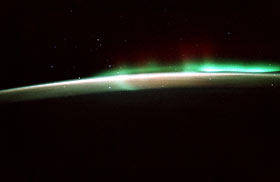
Enregistrez gratuitement cette image
en 800 pixels pour usage maquette
(click droit, Enregistrer l'image sous...)
|
|
Réf : S01682
Thème :
Aurores boréales et australes (15 images)
Titre : Two distinct atmospheric optical phenomena appear in this 35mm photo taken from the crew cabin of the Earth-orbiting Space Shuttle Atlantis on STS-101
Description : (La description de cette image n'existe qu'en anglais)
Two distinct atmospheric optical phenomena appear in this 35mm photo taken from the crew cabin of the Earth-orbiting Space Shuttle Atlantis on STS-101. The thin greenish band stretching along the Earth's horizon is airglow; light emitted by the atmosphere from a layer about 30 km thick and about 100 km altitude. The predominant emission in airglow is the green 5577 Angstrom wavelength light from atomic oxygen atoms. A yellow-orange color is also seen in airglow, which is the emission of the 5800 Angstrom wavelength from sodium atoms. Airglow is always and everywhere present in the atmosphere; it results from the recombination of molecules that have been broken apart by solar radiation during the day. But airglow is so faint that it can only be seen at night by looking 'edge on' at the emission layer, such as the view astronauts have in orbit. The other phenomenon in the photo is the green color of the aurora australis, or 'southern lights'. Aurora occur from about 100 kilometers to 300 kilometers altitude only in the auroral zones at polar latitudes. The green color is also caused by the emission of 5577 Angstrom wavelength light from oxygen atoms that have been raised to a higher energy level (excited) by collisions with energetic electrons pouring down from the Earth's magnetosphere. The light is emitted when the atoms return to their original unexcited state. Astronaut James D. Halsell, Jr., commander of STS-101, commented that the photography does not do justice to just how 'spectacular' the southern lights were on this orbital pass.
|
|

